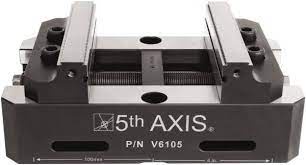Introduction
5-axis machining is a process that involves cutting a workpiece along five different axes simultaneously. This allows for greater flexibility and precision when creating complex geometries. However, specialized work holding devices known as 5-axis vises are necessary to achieve the desired results.
What are 5-Axis Vises?
5-axis vises are work-holding devices that allow for precise positioning of the workpiece in 5-axis machining. These vises have the ability to tilt and rotate, providing greater flexibility and precision. The A and B axes tilt the workpiece along the X and Y-axis, respectively, while the C axis rotates the workpiece around the Z-axis. This allows the tool to access hard-to-reach areas of the workpiece, resulting in a more accurate and precise finished product.
The Advantages of 5-Axis Machining with 5-Axis Vises
The advantages of 5-axis machining with 5 axis vises are numerous. First, these vises allow for greater precision and accuracy. With the ability to position the workpiece at any angle, manufacturers can create complex geometries with ease. Additionally, they reduce setup time and increase productivity by allowing for multiple operations to be performed in a single setup. This means fewer tool changes, less downtime, and ultimately, a more efficient manufacturing process.
Another advantage of 5-axis vises is their ability to handle a wide range of workpiece sizes and shapes. Because they can tilt and rotate, they can accommodate workpieces with irregular shapes and contours, making them ideal for producing parts for the aerospace, medical, and automotive industries.
Choosing the Right 5-Axis Vises
When choosing the right 5-axis vises, there are several factors to consider. These include the size of the workpiece, the weight of the vise, and the type of material being machined. It's essential to choose a vise that is capable of handling the specific requirements of the job, while also providing the necessary precision and accuracy.
Another important consideration is the type of 5-axis vise. There are several types available on the market, including self-centering vises, double-station vises, and modular vises. Self-centering vises automatically center the workpiece, ensuring accurate positioning and reduced setup time. Double-station vises allow for two workpieces to be clamped simultaneously, increasing productivity and reducing setup time. Modular vises are designed to be used in conjunction with other modular components, allowing for greater flexibility and customization.
Conclusion
5-axis machining with 5-axis vises offers numerous advantages, including greater precision and accuracy, reduced setup time, and increased productivity. When choosing a 5-axis vise, it's important to consider factors such as the size of the workpiece, the weight of the vise, and the type of material being machined. By investing in high-quality 5-axis vises, manufacturers can take their manufacturing process to the next level and produce complex geometries with ease.


No comments yet